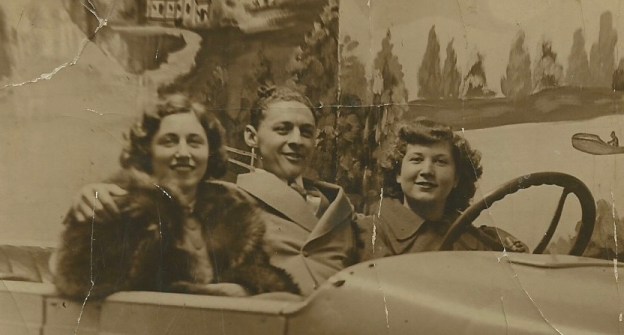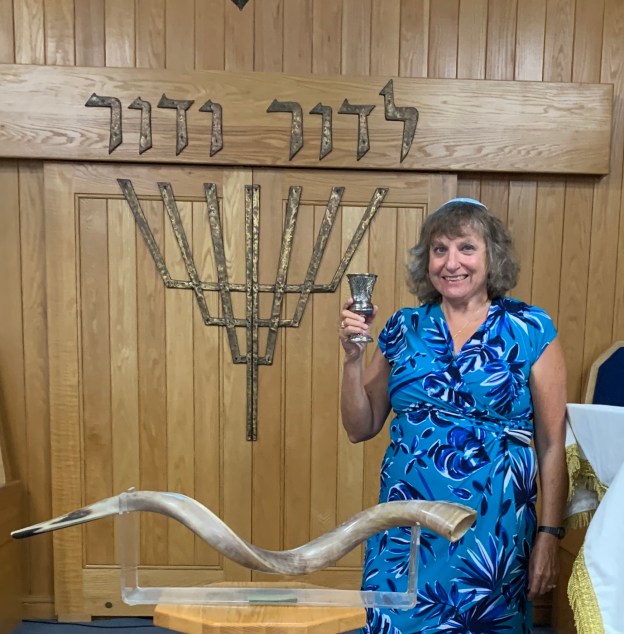My mother Frances Cohen wrote down her memoirs in her late eighties. This story, how she met my father Bill Cohen, is one of our family favorites. More of her stories can be found on this blog as well as in Fradel’s Story, a collection of her articles co-written with me.
Since today is Valentine’s Day, I thought I’d write about my romances until I met my true love. The saying goes, “You have to kiss many frogs until you meet your true love.” Well, I knew many frogs.
I was a senior in high school when I experienced my first romance. I thought that Bernie had the bluest eyes and the curliest hair. I was completely infatuated. The economy wasn’t the best. So, our date consisted mostly of walking and holding hands. Bernie was my date for the Senior Prom. Although he wore a very shabby suit and I borrowed a gown, I thought I was lucky to have a date to the prom with the guy I adored. Things changed after I graduated high school. I got my first job in a toy store for $10 a week six days a week. Bernie didn’t have a job, so in the fall when the leaves died, so did our romance.
That New Year’s Eve was not a happy one for me. Instead of giving me a gift on Christmas Eve, my boss told me he did not need my services anymore. Worse yet, I did not have a date!
Time passed. Both my girlfriends were going steady. Their problem was that their boyfriends did not have a car. Charley, one of their friends, did, so my girlfriends urged me to date him. I was not especially fond of him, but we all were fond of his car. Conveniently, Charley was able to drive the three couples around. The six of us even went to the midnight show at the Apollo Theater.
Financially, things improved for me when I finally got a good bookkeeping job that I loved. When summer arrived, I was given a week’s vacation with pay. I decided to spend it in a hotel in the Catskill Mountains. The hotel had all the ingredients for romance, including swimming, boating, entertainment, and dancing. The first night at the hotel, I was seated next to a tall, handsome guy named Harry. We spent the whole week enjoying all the activities, and by the end of the week, I was completely infatuated with him. We continued dating after I got back from my vacation. I was having a great time as I was dating Charley on Saturday and Harry on Sundays. That situation ended a month later when Charley wanted to get engaged. How could I marry Charley when I was wild about Harry?
When Harry invited me to a formal dinner dance at the Astor Hotel that his firm was sponsoring, I was delighted. I purchased a new black taffeta gown with a matching purse and matching shoes. When Harry arrived to take me to the dinner dance, looking handsome in a tuxedo with a corsage in hand, I was ecstatic. But shortly after the dance, he stopped calling. I was really hurt. I guess I was wild about Harry, but Harry wasn’t wild about me.
I didn’t date anyone interesting for quite a while. Now that I was almost twenty-two years old, my mother was eager to see me settled with a handsome, rich, Jewish man. Cupid stepped in to help. My brother Eli, our cousin Elliot, and their friend Bill Cohen were all working for my Uncle Paul, who had a chain of department stores in Upstate New York. The three of them came home one weekend to visit each of their families. Bill, who had seen my picture at my Aunt Rose and Uncle Ruby’s house, asked Elliot and Eli to fix me up on a “blind” date.
That night I finally met my true love. Bill and I were attracted to each other immediately, and there was instant chemistry from the first moment we saw each other that was to last for a lifetime. My mother’s prayers were answered—almost! Bill was handsome and Jewish. Rich he wasn’t, but two out of three was not bad!
It was to be a long-distance romance. Bill made the eight-hour trip to see me as often as he could, but we only saw one another less than ten times before we married. We wrote every day—I still have his letters in a blue satin bag I keep in my dresser! We had so much in common: our love of reading, our respect for education, our desire for children, and our large, close-knit families. We soon realized that our family trees even had connecting branches as both our families came from small villages near to each other in Lithuania.
Even more astounding, we had actually “met” over twenty years earlier as children through those connections. In 1919, when I was two years old, I contracted the Spanish flu. When my lungs filled up with fluid, the doctor saved my life by cutting an incision into my back to drain them. It was recommended that I spend time away from our tiny apartment in Brooklyn and breathe country air. My mother Ethel quickly made arrangements for the two of us to visit her stepmother’s sister Ittel [Levinson] and her husband Archik Perelman, who lived on a farm in Burlington, Vermont. While there, Ethel and I were visited by Archik’s brother and sister-in-law, Itsik and Sarah Perelman; their daughter Annie [Perelman] Cohen, and her six-year- old son, Bill. There is an expression “My father married my mother. Why do I have to marry a stranger?” Well, Bill didn’t feel like a stranger to me.
On Valentine’s Day, 1940, Bill made a special trip in to see me. We went to the movies and then went out for sundaes at an ice cream parlor. After spending three hours watching Gone with the Wind, Bill must have thought I was Scarlett O’Hara, and so he asked me to marry him. I must have thought he was Rhett Butler, because I said yes. We were married that summer and have spent the last sixty-six years celebrating Valentine’s Days, our anniversary, and our love for each other.






